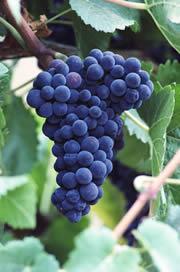 Pick of the bunch: researchers have sequenced a grape that lends its flavour to Champagne.Getty
Pick of the bunch: researchers have sequenced a grape that lends its flavour to Champagne.GettyA French-led team of geneticists has cemented the country's reputation as the world's wine capital — by compiling the complete genetic code of a Pinot Noir grape. Perhaps unsurprisingly, they have discovered that the species has a large repertoire of genes that produce compounds known to give complex flavours to fruit.
Among the almost half-billion DNA 'letters' pieced together by the researchers are a host of genes that encode terpenes and tannins — which any wine buff will tell you are essential for a fine vintage.
The finished sequence is the work of a consortium of French and Italian researchers led by Patrick Wincker, a geneticist based at Genoscope — the French national genetic-sequencing facility in Evry. Full analysis of the more than 30,000 genes contained within the sequence could aid breeding strains with novel flavours or better pest resistance.
It is the first genome of any fruit crop to be sequenced, and only the fourth flowering plant. It also gives evolutionary geneticists a valuable insight into the crucial evolutionary event that divided flowering plants into the two main groups we see today.
Full of flavour
Wine-producing grapes (Vitis vinifera) show lots of genetic variation. So the researchers chose Pinot Noir grapes, which lend their flavour to both Burgundy and Champagne wines, and subjected the grapevines to several generations of inbreeding to get a strain (called PN 40024) with a less variable sequence.
“We may be able to find combinations of genes which could provide new flavours.”
Jean Weissenbach
Genoscope, Evry, France
They then chopped its DNA into millions of fragments, sequenced these, and spliced the code back together using a computer programme to create the full genome. The sequence is published online by Nature1.
The finished sequence shows a huge expanse of terpene and tannin genes compared with other plant genomes studied so far, says team member Jean Weissenbach, who is based at Genoscope. The strain studied contains 70-80 terpene genes alone, he says. Studying these could lead to new styles to tickle the palate, Weissenbach suggests. "We may be able to find combinations of terpene genes which could provide new flavours," he says.
But genetically tweaking the taste of wine won't be straightforward, since flavour also depends upon the conditions under which the grapes are grown and the wine is produced. And there is a lot of genetic variation that the team doesn't yet know about. "There are probably a different number of [flavour] genes from vine to vine; more or less flavour genes may be expressed at a given time; there may be seasonal differences," says Weissenbach.
Helping farmers to beat pests could be more straightforward. Many grape varieties fall victim to pests such as mildew, and spotting the genes grapes use to defend themselves could help in breeding varieties more resistant to attack.
Grain and grape
In evolutionary terms, the grape genome also shows the tell-tale signs of a crucial event, roughly 250 million years ago, that divided the flowering plants into their two main groups — dicotyledons, such as trees, fruit and vegetables; and monocotyledons, which include grass-like crops such as wheat and rice, as well as flowers such as orchids.
ADVERTISEMENT
Drinking lore warns against 'mixing the grain and the grape'. But comparing the grapevine sequence with that of rice reveals that grapes show the hallmarks of a wholesale triplication of the entire genome, which dicotyledons underwent but monocotyledons did not. The pattern is consistent with the organization of the two other dicotyledons genomes so far sequenced, the poplar tree and the genetic model plant Arabidopsis.
But while evolutionary geneticists ponder this, and wine-producers contemplate the prospect of new flavours, the insights provided by genetics can't replace the knowledge gained through centuries of tradition, Weissenbach points out. "We may create an increase in variety in terms of flavours, but in terms of quality that might be a different story," he says.
Visit our genomeunpicked.html">newsblog to read and post comments about this story.
Genoscope, Evry, France
